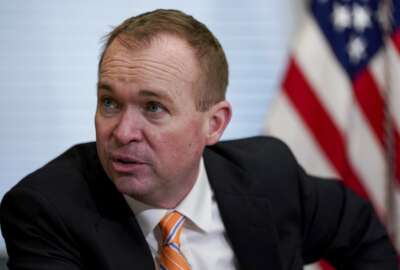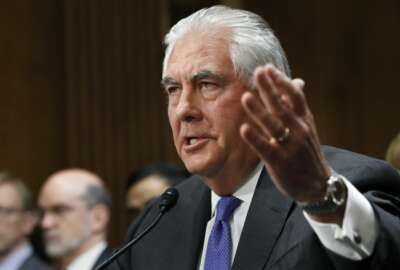
Exclusive
‘There’s a place for everybody’ within SBA reorganization plan
The Small Business Administration is scrutinizing every FTE recruitment request, to ensure maximum employee performance and use of resources.
When the government reorganization guidance came out, many agencies went back to their drawing boards to figure out how to cut costs and shrink their workforce. The SBA headed to the wanted ads.
“We are hiring people,” said Elias Hernandez, SBA’s chief human capital officer. “We probably are one of the few organizations that still can hire new people. We’re always looking for good people to be members of our organization, so if you know any college students finishing their programs, or anyone from a different agency that’s been downsized, [someone] looking for an opportunity, refer them to us.”
That’s not to say SBA has completely dodged the downsizing prompted by the White House’s governtmentwide reorganization, but thanks to good planning — and already operating with a tightened belt — the agency seems to have not only landed on its feet post-reorg directive, but hit the ground running.
“We started this even before the guidance of OMB came out,” Hernandez said. “As soon as the president generated that executive order, we mobilized the senior executive team. What we did is we established an advisory council, the advisory council was broken down into six different subgroups to really … look at everything, don’t leave any rock unturned. Look for places where we can have more efficient, more effective, and more accountable processes and programs. I’m proud of the work we’ve done here. We’ve done a lot of work, but there’s a lot of work ahead of us.”
The advisory council’s six subgroups cover resource management, entrepreneurial development, employee involvement, financial assistance, contracting, and credit and investment programs.
“Everything we do here is within those subcommittees,” Hernandez said. “We are very, very agile here, because we don’t have a lot of layers of bureaucracy, which is part of what we’ve done, kind of flatten the organization.”
Driving performance
SBA and its fellow agencies must submit their reform plans to OMB by June 30, as well as their plans on how they will maximize employee performance.
Hernandez told Federal News Radio that in late May, he attended a CXO meeting to talk about the reform plans. During the meeting, participants broke into small groups to talk about their work, and he ended up at the same table as SBA’s CIO and CFO.
“We basically were sharing our best practices with people. People in other organizations haven’t really started to do a lot of work that needs to be done,” Hernandez said. “They were kind of taking notes on what we’ve done, the processes we’re taking. They were really, really impressed that we have taken this on.”
Hernandez credited the agency’s progress in part to the creation of a Resource Management Board.
The purpose of the board is to review requests and recruitment actions from program offices, Hernandez said, to ensure the agency is following the OMB directive.
“In the past every time an employee left the organization, we immediately received a request for some action to recruit, backfill for it,” Hernandez said. “That’s no longer happening.”
The process is a rigorous one, Hernandez said. The program office submits documentation and justification for the recruitment, and explains to the board why they need to fill that particular position.
“We are able to kind of determine who we are going to allow to recruit in the organization by virtue of the priorities and by virtue of the guidance given by OMB,” Hernandez said. “Obviously our priority is to really build the leadership positions, in particular the district director positions and deputy assistant director positions, and obviously any key positions in the organization, that they help the organization drive performance.”
If the board decides the recruitment meets the criteria, Hernandez’s office gets the go ahead to fill the position.
Hernandez said SBA is also letting the different offices do their own analysis of whether or not they can reorganize themselves and avoid recruiting for a vacant position.
Thanks to new CIO Maria Roat “who truly understands the deficiencies that we have,” Hernandez said, she’s been able to help the agency recognize that automation can give SBA capabilities that they didn’t have in the past.
“What we are doing is basically saying take a look at the organization, are you doing that work now in a different way than it used to be done 10, 15 years ago, by virtue of the support that we are providing you with automation; by virtue of the tracking that we do and the visibility that we have in the number of programs that we have in the organization,” Hernandez said. “Based on the composition of the organization, sometimes we allow the organization to kind of realign resources internally to address the priorities of the organization, so they kind of go through their own internal process in terms of ‘do I really need to have this vacant position filled.'”
When it comes to vacant positions at SBA, Hernandez said there are currently 145 FTEs, but that number can change as the agency works on budget adjustments.
SBA’s proposed fiscal 2018 budget is about $826 million, down from about $831 in 2017.
Those FTE positions are spread out across the agency, though the largest SBA component, the Office of Field Operations, has the most FTEs at 46 vacancies.
The agency’s government contracting, and business development offices, have 13 and 14 vacancies respectively, while the Office of Capital Access has about 25 vacant positions.
“We don’t have an enterprise system that will give us this information, but we do manage the information based upon reporting that is done by the program offices and some of the HR systems that we have to pull the information,” Hernandez said.
Utilizing resources
To help with reform plans, as well as proposed budget cuts for 2018, some agencies are pursuing buyouts and early retirements. The State and Interior departments are reported to be pursuing buyouts, while EPA already set aside $12 million to help cover VERA/VSIP.
Hernandez said SBA is “not at any risk of offering VERA/VSIP, or reduction of force, or anything else.”
Hernandez said SBA already loses about 170 people per year by virtue of retirement and attrition, so “we are really not red.”
“If we were to somehow in other projections be over budget, then we would definitely ask permission to OPM and OMB to conduct VERA/VSIP,” he said.
Hernandez said SBA is still looking at what programs are redundant and making recommendations for the administrator’s consideration when it comes to reallocating resources, without having do a reduction in force or VERA/VSIP program.
“We are really taking this seriously, we are not only looking outside the organization in terms of some of the services that perhaps can be brought into SBA, we are really looking internally about what are we doing, is it making any sense, is it generating the expected outcome and we are making adjustments as we go along,” Hernandez said. “Obviously [the administrator] will have to make some of those decision, some of those decisions ultimately are going to effect the workforce reduction plan that I’m going to submit to OMB. Also it’s probably going to give me a better idea how it’s going to shuffle some of the resources in the organization, but the thing about it is there’s a lot of work in our organization, we are actually exceeding the agency priority goals in many respects. We know that off the top we do have changes and things like that, uncertainty in the federal workforce; we need to be very smart how we communicate this to our employees, to make sure that they understand that there’s a place for everybody in this organization.”
Copyright © 2025 Federal News Network. All rights reserved. This website is not intended for users located within the European Economic Area.





